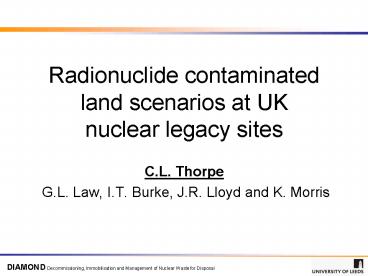Radionuclide contaminated land scenarios at UK nuclear legacy sites PowerPoint PPT Presentation
1 / 16
Title: Radionuclide contaminated land scenarios at UK nuclear legacy sites
1
Radionuclide contaminatedland scenarios at
UKnuclear legacy sites
- C.L. Thorpe
- G.L. Law, I.T. Burke, J.R. Lloyd and K. Morris
DIAMOND Decommissioning, Immobilisation and
Management of Nuclear Waste for Disposal
2
The Project
- Project summary
- Model site
- Sellafield nuclear facility
- Cumbria, UK.
- Focus
- The treatment of co-contaminants strontium and
technetium in a variety of conditions including
high nitrate and low pH. - Scenarios
- Bio-stimulation by electron donor addition in
high nitrate/ low pH sediment - Nano-scale/micro-scale Zero Valent Iron addition
Figure 1 www.visitcumbria.com
DIAMOND Decommissioning, Immobilisation and
Management of Nuclear Waste for Disposal
3
Geochemical Conditions
- Nuclear facility conditions
- pH range (5.5-10)
- High nitrate (0-gt100 mM)
- Localised high bicarbonate concentrations
- Contamination of problematic radionuclides
- Technetium-99
- Strontium-90
- Uranium
- (Rifle, CO, US Sellafield, UK Naturita, CO, US
ORFRC, US Hanford, US Dounreay, UK Drigg, UK)
DIAMOND Decommissioning, Immobilisation and
Management of Nuclear Waste for Disposal
4
My Project Outline
- Aim to investigate the potential methods for
remediation of strontium and technetium
contamination in the far field at a range of pH
and potentially high nitrate. - The effect of nitrate as a co-contaminant on
terminal electron accepting processes (TEAPs) - The potential co-treatment of strontium and
technetium with nano-scale zero valent iron
(nZVI) - The effect of nZVI on the microbial community and
progression of TEAPs
DIAMOND Decommissioning, Immobilisation and
Management of Nuclear Waste for Disposal
5
Nitrate Co-contamination
- Question What is the effect of high nitrate (100
mM) on the progression of terminal electron
accepting processes (TEAPs) in Sellafield
sediments? - Nitrate is present at nuclear facilities due to
the use of nitric acid in the nuclear fuel cycle - Nitrate can inhibit TEAPs as it competes with
metals and radionuclides as an electron acceptor
in anaerobic respiration. - Previous studies show that metal/radionuclide
reduction does not take place until nitrate
reduction is complete
DIAMOND Decommissioning, Immobilisation and
Management of Nuclear Waste for Disposal
6
Experimental Methods
- Monitoring progression of TEAPs
- Spectrophotometrically
- nitrite,
- Mn
- Fe(II)
- Fe(II)/Fe(III) in sediments (acid extraction)
- Ion Chromatography
- Nitrate
- Sulphate
- Probe
- Eh
- pH
Microcosms
Headspace gas Argon
Sellafield representative groundwater (Wilkins et
al. 2006) 100 ml
Sellafield sediment 10g
DIAMOND Decommissioning, Immobilisation and
Management of Nuclear Waste for Disposal
7
Nitrate Scenarios
Microcosm work the effect of 100 mM nitrate on
terminal electron accepting processes (TEAPs) in
Sellafield Sediment at pH 5.5 and pH 7.
Microcosm conditions Nitrate concentrations Initial pH
1 0.3 mM nitrate 5.5
2 2 mM nitrate 5.5
3 10 mM nitrate 5.5
4 100 mM nitrate 5.5
5 0.3 mM nitrate 7
6 100 mM nitrate 7
DIAMOND Decommissioning, Immobilisation and
Management of Nuclear Waste for Disposal
8
Results
DIAMOND Decommissioning, Immobilisation and
Management of Nuclear Waste for Disposal
9
Results 10 mM nitrate, pH 5.5
DIAMOND Decommissioning, Immobilisation and
Management of Nuclear Waste for Disposal
10
Results 100 mM nitrate, pH 7
Fe (II) sediment
pH
Nitrite (mM)
Eh
DIAMOND Decommissioning, Immobilisation and
Management of Nuclear Waste for Disposal
11
Discussion pH 5.5 (0.3, 2, 10 and 100 mM
nitrate)
- Iron reduction did not commence until nitrate
reduction had reached completion and all nitrite
was reduced. - Results at pH 5.5
- In microcosms containing 0.3, 2 and 10 mM nitrate
TEAPs progressed to iron reduction within 25
days. In microcosms containing 100 mM nitrate,
nitrate reduction is ongoing at 80 days - A rise in pH was observed in all microcosms, the
extent of pH rise was dependent on initial
nitrate concentration but 10 mM was sufficient
for pH to rise from 5.5 to 7 during production of
nitrite.
DIAMOND Decommissioning, Immobilisation and
Management of Nuclear Waste for Disposal
12
Discussion pH 7 (0.3 mM and 100 mM nitrate)
- Iron reduction did not commence until nitrate
reduction had reached completion and all nitrite
was reduced - Results at pH 7
- Microcosms containing 0.3 and 100 mM nitrate
progressed to iron reduction within 15 and 60
days respectively. - In sediment containing 100mM nitrate pH rose to
9.4 during nitrate reduction and a darkening of
the pore water was observed thought to be
leaching of organic matter.
DIAMOND Decommissioning, Immobilisation and
Management of Nuclear Waste for Disposal
13
Microbial Analysis
DIAMOND Decommissioning, Immobilisation and
Management of Nuclear Waste for Disposal
14
Future Questions
Further work- scenarios to treat strontium and
technetium co-contaminants Question What is
the optimum pH for Sr sorption to Sellafield
sediment? Question How does nZVI affect the pH
and Eh of a system when it is initially added and
over time? Question What effect does nZVI
addition have on iron mineral phases and on Sr
Sorption and mobility? Question What effect
does nZVI addition have on the microbial
community? Can hydrogen production act as an
electron donor?
DIAMOND Decommissioning, Immobilisation and
Management of Nuclear Waste for Disposal
15
Rationale for nZVI Work
- Fe0 2H2O--- Fe2 H2 2OH-
- nZVI reduces everything indiscriminately so will
affect nitrate, Mn and Fe species as well as
redox sensitive radionuclides Tc and U. - OH? produced during iron corrosion may raise the
pH and aid bioreduction. Increased pH aids
strontium sorption and co-precipitation with Ca
minerals. - Hydrogen production may stimulate the in situ
microbial community and help maintain reducing
conditions.
DIAMOND Decommissioning, Immobilisation and
Management of Nuclear Waste for Disposal
16
Eventual Aim
- 24 month aim to design flow through columns
suitable for use with Tc and Sr to demonstrate
bioremediation scenarios - Electron donor addition
- pH neutralisation
- Zero valent iron addition
- Combinations of the above
Magga et al. 2008- column to measure pesticide
contaminate spread
DIAMOND Decommissioning, Immobilisation and
Management of Nuclear Waste for Disposal

